New iPhone App: DMX Color Mixer
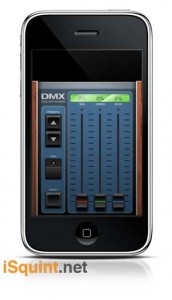 I just heard about a new iPhone app that was released from 40oz Apps, DMX Color Mixer. You might know one of their other iPhone apps for lighting, DMX to Dip. 40oz Apps create simple and easy to use iPhone apps not only for lighting people, but also a couple BAC calculators for those who have party a little to hard.
I just heard about a new iPhone app that was released from 40oz Apps, DMX Color Mixer. You might know one of their other iPhone apps for lighting, DMX to Dip. 40oz Apps create simple and easy to use iPhone apps not only for lighting people, but also a couple BAC calculators for those who have party a little to hard.
DMX Color Mixer is exactly as the name suggest, a color mixer that is able to produce the intensity level or DMX levels of an RGB color. Pretty simple right? Here is more from 40oz Apps.
This super simple app is a reference for setting color values in DMX setup. Simply move one of the three faders to see how it affects the color at the top. You also can scroll through presets to see what values are used for common colors. [white, black, purple, magenta, blue, aqua, green, yellow, orange, red, amber]. The “DMX”toggles between DMX values (0-255) and percentage values, (0-100). The reset button resets all values to zero.
Nice little app for what it does. It really has a nice look to it and gives the feeling of a console. What I would like to see is give me another option to mix colors. The faders are RGB, or Red, Green, Blue. How about adding a toggle switch to allow us to mix in CMY mode and HSV mode? Just a thought.
DMX Color Mixer runs .99 cents in the iTunes App Store. For more information about the app or any of the other apps that 40oz Apps developed, visit their website at www.40ozapps.com.
[nggallery id=24]
Dr. DMX YouTube Channel
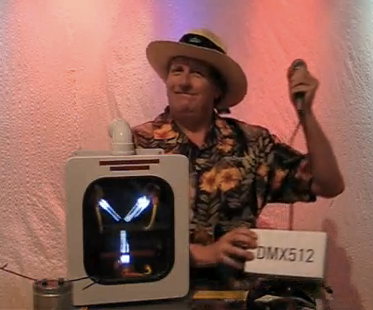 Jfleenor, a user on the ControlBooth.com just recently put up a post about Dr. DMX, better known as Doug Fleenor from Dour Fleenor Design. Jfleenor is actually Janell Fleenor, Doug’s Daughter and Master DMX Blender from LDI 2009.
Jfleenor, a user on the ControlBooth.com just recently put up a post about Dr. DMX, better known as Doug Fleenor from Dour Fleenor Design. Jfleenor is actually Janell Fleenor, Doug’s Daughter and Master DMX Blender from LDI 2009.
Janell posted over at the ControlBooth about DFD, (Doug Fleenor Design) latest adventures, the Dr. DMX YouTube Channel. Dr. DMX himself has started an informational video series about the properties and functionality of DMX. The series kicks off with two videos with Dr. DMX talking about the importance of using the proper DMX cable and how DMX works over cables.
When you get a chance, head over to the Dr. DMX YouTube Channel to see the animated Dr. at work. He really is a mad scientist some times! ;) Thanks David for point this out to me!
Dr. DMX Develops Green Dimmers
 Leave it to the good doctor, Doctor DMX, aka Doug Fleenor Designs, (DFD) to develop a new and interesting product for LDI this year. We all know that Doug Fleenor Design comes out with some pretty remarkable DMX products like the DMX/RDM Coffee Pot and the DMX-a-Sketch at past LDI’s. This year was no let down.
Leave it to the good doctor, Doctor DMX, aka Doug Fleenor Designs, (DFD) to develop a new and interesting product for LDI this year. We all know that Doug Fleenor Design comes out with some pretty remarkable DMX products like the DMX/RDM Coffee Pot and the DMX-a-Sketch at past LDI’s. This year was no let down.
Doug Fleenor Design had a DMX Blender on had to mix up some lovely adult drinks during the show. On a side note, when o when is DFD going to produce these wonderful devices?! I would love to operate my entire kitchen off a lighting console!
What DFD did have on the show floor that we can purchase in the near future is DFD’s entry into the dimmer world with the Green Dimmer. DFD designed the Green Dimmer as low power dimmer to drive 250 watt or less loads for such luminaries like LEDs, CFL and even neon.
The Green Dimmer operates off a 120v, 20amp power input and splits it off into 8, 2amp dimmable outlets. Would you be surprised to know that this is of course controlled by DMX? All of this fits into a 12″ x 12″ x4″ NEMA 1 enclosure and runs super quite as there are no fans or filters.
I was not able to get a price out of the good doctor and information has not reached the DFD website as of yet. Look for more information about the Green Dimmer from Doug Fleenor Design here on iSquint. To learn more about the neat DMX products the good doctor produces, visit DFD’d website at www.dfd.com.
Baxter Controls Pocket iPhone DMX App
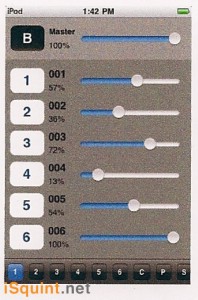 During LDI 2009, I got a chance to stop by the BCI or Baxter Controls booth to take a look at his latest product, the iPhone Virtual Pocket Console app. The iPhone app is still under development and is not ready for release as of yet. BCI did have a beta version of the App on their iPod Touch running the booth and the Par-B-Q cooker.
During LDI 2009, I got a chance to stop by the BCI or Baxter Controls booth to take a look at his latest product, the iPhone Virtual Pocket Console app. The iPhone app is still under development and is not ready for release as of yet. BCI did have a beta version of the App on their iPod Touch running the booth and the Par-B-Q cooker.
The Virtual Pocket Console App utilizes wireless network protocol to control DMX. The iPhone/iPod Touch connect to the BCI Pocket Console Net/DMX converter box to translate the signal to 5-pin DMX. I am still a little unsure if BCI is using Art-Net or not, but time will tell.
The Virtual Pocket Console can Patch up an entire universe of DMX512 and give you the ability to check dimmers, channel levels, and record simple looks.
A time frame or pricing has not been released yet. I am expecting to see something more about the iPhone app in the first quarter of 2010.
What to see more about the neat products from BCI, visit their website at www.dmx2go.com.
[nggallery id=16]
Lumens in the Air with LumenRadio
 One of the newer products that I got a chance to play with at LDI this year that wasn’t an LED fixture was the LumenRadio system. LumenRadio made it’s debut into the entertainment lighting industry at the PLASA show this year and took home PLASA’s 2009 Award for Innovation.
One of the newer products that I got a chance to play with at LDI this year that wasn’t an LED fixture was the LumenRadio system. LumenRadio made it’s debut into the entertainment lighting industry at the PLASA show this year and took home PLASA’s 2009 Award for Innovation.
LumenRadio is a wireless system to send DMX information over a wireless network. What is unique about Lumen Radio is that it is the first smart wireless system to automatically adapt to its surroundings. Meaning, that the Lumen Radio system looks for open or un used space on a wireless bandwidth and takes advantage of that un used space to transmit and receive DMX singal.
LumenRadio launched uses a wireless technology called CRMX which stands for Cognitive Radio Multiplexer. CRMX was specifically developed to meet the demand for reliable, easy to use, and cost effective wireless lighting controls.
So what does Cognitive Coexistence mean for us?
Wireless DMX distribution systems operate on the same license free frequencies as W-LAN (WiFi), ZigBee, Bluetooth, some wireless intercoms, etc. Interference between such systems has been a growing problem in the industry with no available solution. CRMX is the first system to continuously scan the radio spectrum and dynamically adapt its frequency hopping patterns. This eliminates interference and maximizes performance of all radio systems in the same radio frequency sphere. In short, it’s a smart radio that adapts without having the user doing anything at all.
CRMX Nova features a number of unique features, such as:
- Automated Cognitive Coexistence. The unique CRMX technology makes sure that your wireless transmissions never disturb, or are disturbed by, other wireless equipment. This fully automated feature offers unrivaled convenience and peace of mind during operation.
- Fidelity. The DMX frame output is identical to the frame input. DMX frames will not be only half updated.
- Error correction. Advanced algorithms recreate corrupt or lost radio packets.
- Compliance. Non-compliant DMX signals are corrected to meet the DMX512-A standard.
- DMX synchronization. Precision timing mechanism guarantees synchronized frame delivery. The DMX frame will be outputted at all of the receivers synchronized. This ensures that no time differences occurs is the signals.
- Low latency. Industry best; below 5ms even in multi-universe systems.
- High security. Strong 128 bit encryption keeps hackers out.
LumenRadio has a number of products to transmit and receive signal all in various “sizes”. You can go from a single universe of DMX on the CRMX Nova TX, to two universe with the CRMX Nova TX2 and finally the CRMX Nova TX2 RDM which transmits both DMX and RDM, (Remote Device Management).
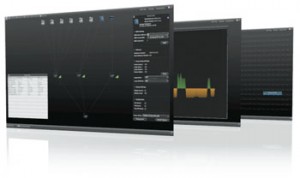 What caught my attention at the LumenRadio booth was their SuperNova software. CRMX SuperNova is an RDM Controller that comes free of charge with LumenRadio’s CRMX Nova™ RDM products. CRMX SuperNova lets you set up, monitor and troubleshoot RDM systems. Once you have connected your devices, just run a discovery process that will find all your RDM enabled devices in the network. You can map your RDM transmitters and Recivers in an view similar to how you physically have them laid out and click on each of the devices to “identify” them as well as get vital information from them.
What caught my attention at the LumenRadio booth was their SuperNova software. CRMX SuperNova is an RDM Controller that comes free of charge with LumenRadio’s CRMX Nova™ RDM products. CRMX SuperNova lets you set up, monitor and troubleshoot RDM systems. Once you have connected your devices, just run a discovery process that will find all your RDM enabled devices in the network. You can map your RDM transmitters and Recivers in an view similar to how you physically have them laid out and click on each of the devices to “identify” them as well as get vital information from them.
SuperNova also give you a graphically view of the full spectrum of wireless signal to see where open sections of the spectrum as well as limit which part of the spectrum to use or avoid. On the RDM side, you can quickly re-address a device any where on the DMX universe by simple clicking and dragging the device to it’s new address. The entire SuperNova software runs on Java and is able to work on any platform of computers.
For more infomation on the SuperNova Software or any of LumenRadio’s products, visit their website at www.lumenradio.com.
Swisson to Announce New Sine Wave Dimmer
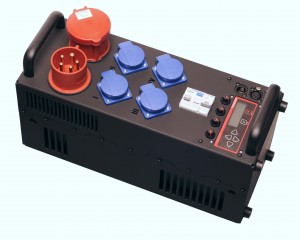 Swisson is preparing to announce a couple of new products at the LDI Show tomorrow. The first being the XSD-D Satellite Sine Wave Dimmer pictured right. The XSD is a pretty flexible device as is can be operated as a dimmer, switch or a fixed stabilized voltage source.
Swisson is preparing to announce a couple of new products at the LDI Show tomorrow. The first being the XSD-D Satellite Sine Wave Dimmer pictured right. The XSD is a pretty flexible device as is can be operated as a dimmer, switch or a fixed stabilized voltage source.
The XSD is extremely quiet, currently used in TV Studios. With the Uplink\Pass-Through option for power, multiple XSD-D’s can be daisy chained to meet your specific power needs.
The Power Manager ensures safe operation when working on the limit of the mains supply, by limiting the total power used as per your requirements and specification.
Swisson is also going to be debut a new line of RDM Splitter which will be available in a variety of enclosures and connection types. The RDM splitter is expected to be ETL listed and certified by the beginning of the new year.
For more information on these products from swisson, visit their website at www.swisson.com or visit their booth, # 836 at the LDI Show.
ELC Lighting To Show off DMX-Over-Ethernet Devices For First Time at LDI
 ELC Lighting out of Switzerland will be exhibiting at the LDI Show for the first time. ELC Lighting specializes in DMX distribution networks and specialized control products such as the dmXLAN node6x, their latest product. The dmXLAN node6x is and all in one DMX.ethernet solution. It features 6x DMX inputs/output ports and is fully compatible with ELC’s free dmXLAN software with advanced DMX channel merging and patching. The dmXLAN node6x also features a 5-port 10/100mb ethernet switch.
ELC Lighting out of Switzerland will be exhibiting at the LDI Show for the first time. ELC Lighting specializes in DMX distribution networks and specialized control products such as the dmXLAN node6x, their latest product. The dmXLAN node6x is and all in one DMX.ethernet solution. It features 6x DMX inputs/output ports and is fully compatible with ELC’s free dmXLAN software with advanced DMX channel merging and patching. The dmXLAN node6x also features a 5-port 10/100mb ethernet switch.
Some of the other products ELC Lighting will have on hand are their DMX Show Recording devices and their focusHAND riggers radio remote. To learn more about ELC Lighting, visit their website at www.elclighting.com or visit their booth, 562 at LDI this week.
Two New Products from Enttec at LDI
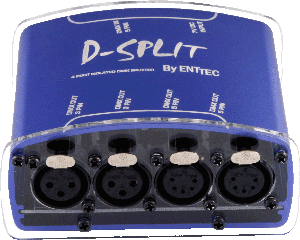 Looks like Enttec will be expanding their product line this year at LDI. The boys from down under are preparing to announce a new DMX opto-splitter to go with their DMXis controller. What is nice is that the D-spilter is not limited to just being used with the DMXis. It is a low cost, 4 way optically isolated splitter that can be used in any lighting system when more “branches” of DMX are required.
Looks like Enttec will be expanding their product line this year at LDI. The boys from down under are preparing to announce a new DMX opto-splitter to go with their DMXis controller. What is nice is that the D-spilter is not limited to just being used with the DMXis. It is a low cost, 4 way optically isolated splitter that can be used in any lighting system when more “branches” of DMX are required.
I haven’t heard about any pricing as of yet or seen it on their website.
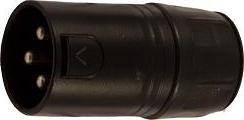 The other new product Enttec is preparing to announce is a “new” 3 or 5 pin DMX terminator. Why are we excited to see this? Well, it is a pretty simple device right, take a 5 or 3 pin male DMX connector and solder a 120 ohm resister across pins 2 and 3 right? Well of course! What is neat about Enttec’s terminator is that the back side has a closed off cover rather then using the standard sleeve to a cable on the back side. This is something that is so simple but maybe never thought of before.
The other new product Enttec is preparing to announce is a “new” 3 or 5 pin DMX terminator. Why are we excited to see this? Well, it is a pretty simple device right, take a 5 or 3 pin male DMX connector and solder a 120 ohm resister across pins 2 and 3 right? Well of course! What is neat about Enttec’s terminator is that the back side has a closed off cover rather then using the standard sleeve to a cable on the back side. This is something that is so simple but maybe never thought of before.
The Enttec DMX terminator goes for $11 USD and can be purchased right from their website, www.enttec.com. To see these and other Enttec products, visit their booth, 1181 at the LDI Show.
A Survey: Use of DMX vs. Ethernet
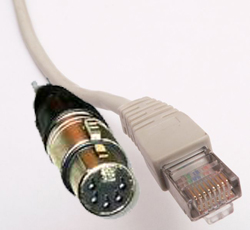 A long time reader and now friend of ours, Ben Peoples has put together a survey on Google Spreadsheets about using DMX 5-wire and DMX over ethernet in the rental market.
A long time reader and now friend of ours, Ben Peoples has put together a survey on Google Spreadsheets about using DMX 5-wire and DMX over ethernet in the rental market.
I’m trying to establish a baseline for how much people are using DMX-over-ethernet versus DMX over DMX wire in rental environments. From my perspective, given a four-wall rental space with some minimal accommodations (disconnects, some in-conduit wiring), how much are you expecting or planning to use DMX versus ethernet.
When you have a moment, visit the Google Spreadsheet page to take the survey.
Thanks @bpeoples!
Enttec Introduces Din-LED4PX LED Driver
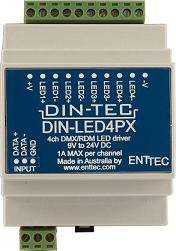 Enttec, the makers of such products as the DMXis and the MIDI Wing Panel has just introduced their latest control device, the DIN-LED4PX. It may seem like a complicated name, but it is a simple device. It is a 4 channel, constant voltage LED driver with DMX/RDM inputs that fits right to a din rail system!
Enttec, the makers of such products as the DMXis and the MIDI Wing Panel has just introduced their latest control device, the DIN-LED4PX. It may seem like a complicated name, but it is a simple device. It is a 4 channel, constant voltage LED driver with DMX/RDM inputs that fits right to a din rail system!
For those of you wondering what a din rail systems is. A Din Rail System is a collection of unique “open architecture” high density rail-mounted components designed specifically for remote control and acquisition. Featuring a highly integrated modular design and support for industry standard Modbus ASCII, RTU and TCP protocols, RAIL components are ideal for use in all industries. All components may be used stand-alone or integrated with other components of the system.
Back to the Din-Tec device. There are 4 LED ports on a 10 way screw connector as pictured on the right for controlling up to 4 channels. The device also has 1 input of DMX, also on a screw connector located at the bottom. Each channel can control up to 1A @ 24V which would come from an external power supply. The LEDs are dimmed with a 500Hz PWM signal, with 8 bits of resolution. DMX addressing happens over standard RDM controllers.
The Enttec DIN-LED4PX retails for $99 USD. For more information or to find a dealer near you, visit Enttec’s website at www.enttec.com.
amBX UK Ltd Preps Debut of amBIENT XC Lighting Controller
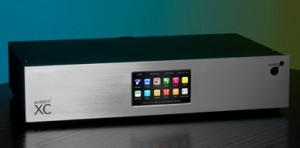 If you plan on attending PLASA Show next month in London, be sure to stop by the amBX UK Ltd. booth to preview their latest lighting control system, the amBIENT XC. The one line that has peaked our interest from the press release is…
If you plan on attending PLASA Show next month in London, be sure to stop by the amBX UK Ltd. booth to preview their latest lighting control system, the amBIENT XC. The one line that has peaked our interest from the press release is…
The product is billed as a radically changing the way in which light and space are designed to create immersive entertainment experiences using light, video and sound.
We are not quite sure how this is a radical change of how lighting and video systems are controlled as it does not mention more then the amBient XC is a stand-alone DMX512 controller powered by amBX technology. The company, amBX is claiming that this new technology is going to be the new standard in creating and delivery an immersive entertainment experience.
The amBIENT XC has a variety of AMbx modes pre built into the box for some “standard” LED effects such as Fire Flame, Pacific Tide, (personally, we would like to see an ATLANTIC tide), Warm Breeze and others that are also customizable. All of these modes can be executed and changed or modified by touchscreen on the front of the box. There is also some downloadable PC design tools for greater control options and configuration.
From what we have read and seen on the website, the amBIENT XC is a pretty cool, self contained DMX playback unit. It can be a great option for night clubs, restaurants and other architectural spaces that have LED lighting and want to have “effects” running with the tap of a screen.
The amBIENT XC is being distributed in the US by TMB. Since the amBIENT XC has not be “offically” announed yet, we can’t find a retail price. For more information on the amBIENT XC, visit amBX’s web site at www.ambx.com.
Cpoint Lighting XLR to RJ45 Adapters
 Have you found DMX cable to be expensive? A good rule of thumb when it comes to purchasing DMX cable is that a foot of DMX cable with connectors can run about $2.50 to $3.00 a foot and up. It all depends on what type of connector is used and the type of cable as well.
Have you found DMX cable to be expensive? A good rule of thumb when it comes to purchasing DMX cable is that a foot of DMX cable with connectors can run about $2.50 to $3.00 a foot and up. It all depends on what type of connector is used and the type of cable as well.
In recent years, DMX has started to find its way in the cat5 cable and network protocols with ArtNet and other translating protocols to send signal. But at the end of the line, there needs to be a node of some sort translating that protocol back into DMX512 with a 5 pin connector to communicate with a device.
Cpoint Lighting has developed a new adopter that lets DMX run over cat5 cable with out the need for a protocol or any type of signal translation. Basically, we turn a cat5 cable into a less expensive DMX cable with the XLR to RJ45 adapter. Cpoint makes a 5 pin male and female adapter as well as a 3 pin male and female adapter. At $16.95 a piece, these adapters can be re-used over and over again and make any length of DMX cable needed. All that is required is finding the correct length of cat5 cable.
For more information or to find a dealer near you for the the XLRJ45 adapters, visit Cpoint Lighting’s website at www.cpoint-lighting.com
LatestHeadlines
- Upgrading Your Toolbox: City Theatrical DMXcat-E and DMXcat Multi Function Test Tool
- Claypaky Bringing Back the Sexy to Par Cans with the Midi-B FX
- Ayrton Evolves the Cobra, the Cobra2 Developed for the US Market
- MA Lighting Intros grandMA3 onPC Fader Wing and DIN-Rail Nodes
- Live Events LEVL Up Fest: A Festival to Aid our Industry